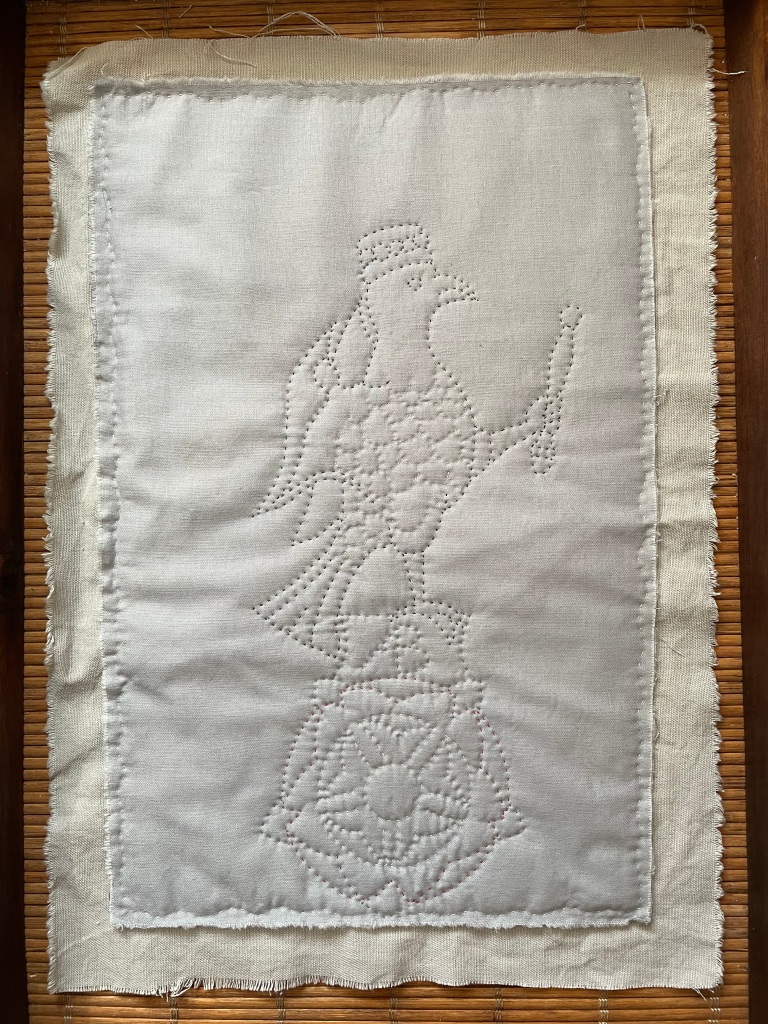
Since finishing the first Wolf Hall Quilt, I have been reflecting on the way in which I will continue this project, and over the last few months I have changed my approach. It hasn’t been an easy process; I have thought a lot about what worked in the first stage (the detail) and what didn’t work (the overall shape of the quilt unrolled), and how I restricted myself too much when working on the first piece. After various false starts and a period of being stuck, I now feel very clear about my direction of travel – and that’s partly because of my experience of making a couple of small falcon pieces. Falcons might be the name of the first chapter of the second book in the trilogy, Bring Up the Bodies, but the Falcon was also the symbol of Anne Boleyn and her family.
I have always been struck by the way in which Hilary Mantel writes about the symbols relating to the various Queens of England in the Cromwell Trilogy. Mantel writes a lot about the changing of symbols with the changing of Queens – from the pomegranate (Katherine of Aragon) to the falcon (Anne Boleyn) to the phoenix (Jane Seymour), how they have to be painted over, unpicked, or otherwise obliterated. Over the last few months I have been stitching representations of these symbols with a view to eventually putting them together into a Book of Queens. And that has meant stitching falcons.
Although Henry VIII wanted no reminders of Anne Boleyn and her symbols, nearly 500 years after her fall, falcons can still be spotted at Hampton Court, in the ceiling of what’s now known as the Anne Boleyn Gateway. In Bring Up the Bodies, Mantel’s Cromwell pictures himself “perched like a carved falcon over a doorway” – and, like him, these remaining falcons can now watch the comings and goings of those who enter the Great Hall and the chambers beyond.


And at the Tower of London, in the Beauchamp Tower, there is a rough falcon carving that might relate to Anne Boleyn. Historian Eric Ives, in The Life and Death of Anne Boleyn (Blackwell Publishing Ltd, 2004, p.364), wrote that this is Anne’s
“most poignant memorial… Which of her ‘lovers’ made it we do not know, but the image is unmistakable. The tree stump is there – the barren Henry – the Tudor rose bursting into life, the perching bird whose touch wrought the miracle. But there is one change to the badge which Anne had proudly flourished in the face of the world. This falcon is no longer a royal bird. It has no crown, no sceptre; it stands bareheaded, as did Anne in those last moments on Tower Green.”
Eric Ives, The Life and Death of Anne Boleyn, (Blackwell Publishing Ltd, 2004) p.364.

The Tower’s own description, to be found on the wall nearby, is less definite and reads “Unknown. The shield is thought to be Anne Bolyen’s falcon carved by one of her supporters”. I’ve seen speculations that it might have been carved by Anne’s brother George, or by the poet Thomas Wyatt, both prisoners at the Tower, and probably the best known of Anne’s supporters, but really we cannot know who made it.
Does Mantel present a scene any of Anne’s alleged lovers (Henry Norris, William Brereton, Francis Weston, Mark Smeaton, brother George, or Thomas Wyatt) carving this uncrowned falcon? No. In Mantel’s telling in Bring Up the Bodies, George Boleyn is imprisoned “in his light circular room in the Martin Tower”. Thomas Wyatt is seen by Richard Cromwell “looking down from a grate in the Bell Tower”; and as Mantel notes in The Mirror and the Light, Wyatt’s own poetry references the Bell Tower. And the exact location of the other four prisoners is not present in the text.
In fact there is just one mention of the Beauchamp Tower in the trilogy, and that is by Cromwell himself. After his arrest, in The Mirror and the Light, he is held in the Queen’s Apartments, before being moved to the Bell Tower. “Can I not go to the Beauchamp Tower?” he asks, to be told that it is already occupied.

While the trilogy does not mention this carving, The Mirror and the Light makes reference to “The Boleyn’s’ white falcon [hanging] like a sorry sparrow on a fence, while the Seymour phoenix is rising”, and that makes me think of this carving. And there’s something else for me to think about. To me, the “tree stump” on which the carved falcon is perched looks a little like a pomegranate; and my stitched adaptation deliberately plays on that. I wanted the now defeated and uncrowned falcon to still be determined to show dominance over the pomegranate, even in its final days.
Looking at these falcons, and their recurrence in the text throughout the trilogy has been invaluable in working out my approach to the next stage of my sewing project. Rather than taking the books individually, and working in order as I did with the Wolf Hall quilt, I am now working thematically across the three books. I’ve been thinking about snakes and eels, the river and the buildings. Last night I even dreamt that I was embroidering the food Cromwell eats. The Cromwell trilogy continues to captivate me and my stitching hands.
Big projects do have a tendency to shift under your feet, don’t they! It is going to be interesting to follow this new direction.
LikeLiked by 1 person
It is fascinating following your thoughts about Mantel’s books, seeing your quilting choices, and learning more about the Queens’ symbols. Thank you!
I’ve never read the books and even I think, sometimes in the morning, so now get up.
LikeLiked by 1 person
The books are an endless source of fascination to me; there is so much in there. I really think that they can be read differently according to one’s interests, as they are so rich.
LikeLike